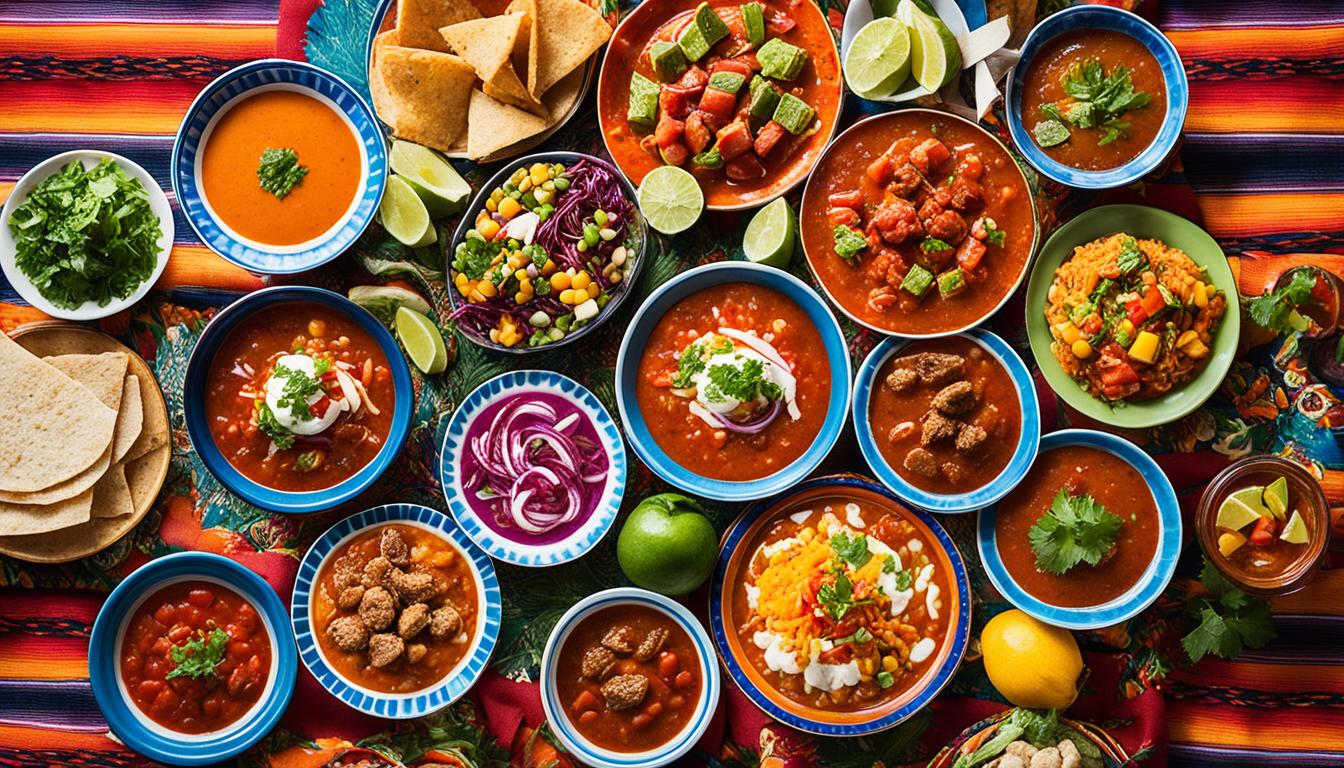Explore the Richness of Bolivian Culture Today
Have you ever wondered about the vibrant traditions, colorful festivals, and mouthwatering cuisine of Bolivia? In this article, we will take you on a fascinating journey through the captivating world of Bolivian culture. From the enchanting beauty of traditional dances to the indigenous heritage that shapes the country’s identity, Bolivia offers a cultural tapestry like no other. Get ready to immerse yourself in the richness and diversity of Bolivian culture.
Key Takeaways:
- Bolivian culture is a unique blend of indigenous heritage and colonial influences
- Traditional Bolivian cuisine features a fusion of flavors influenced by indigenous and Spanish traditions
- Religion plays a significant role in Bolivian culture, with a mix of Catholic and indigenous beliefs
- Bolivia’s vibrant festivals combine indigenous celebrations with Catholic traditions
- Language and cultural diversity are integral to Bolivian society
Traditional Bolivian Cuisine
Bolivian cuisine is a reflection of the country’s history and cultural influences. Traditional dishes feature staples such as potatoes, corn, quinoa, and beans, influenced by indigenous traditions. Spanish influences have added rice, chicken, beef, and wheat to the culinary scene.
One of the most famous traditional dishes in Bolivia is Silpancho. It consists of rice, boiled potatoes, meat, tomatoes, onions, beets, parsley, and a fried egg. This hearty and flavorful dish showcases the fusion of flavors that characterize Bolivian cuisine.
Bolivia is also known for its unique delicacies. One such delicacy is Cuy, which is roasted guinea pig. It is a popular dish among the indigenous communities and is often served during special occasions and festivals. Another notable dish is pique a lo macho, a delicious combination of grilled beef and sausage, served with potatoes, onions, and chili peppers.
These traditional dishes not only highlight the indigenous influences but also demonstrate the fusion of flavors that make Bolivian cuisine distinct. The country’s diverse cultural heritage is evident in the variety of dishes and the use of local ingredients.
| Dish | Description |
|---|---|
| Silpancho | A traditional Bolivian dish consisting of rice, boiled potatoes, meat, tomatoes, onions, beets, parsley, and a fried egg. |
| Cuy | A roasted guinea pig dish, popular among indigenous communities in Bolivia. |
| Pique a lo macho | A flavorful dish made with grilled beef and sausage, served with potatoes, onions, and chili peppers. |
Indigenous Influences in Bolivian Cuisine
Bolivian cuisine is heavily influenced by indigenous traditions. Staples such as potatoes, corn, quinoa, and beans have been cultivated and consumed by indigenous communities for centuries. These ingredients form the foundation of many traditional Bolivian dishes.
Indigenous cooking techniques, such as boiling, steaming, and roasting, are still prevalent in Bolivian cuisine. The use of herbs, spices, and local produce adds unique flavors and aromas to the dishes, creating a distinct culinary experience.
Lorem ipsum dolor sit amet, consectetur adipiscing elit, sed do eiusmod tempor incididunt ut labore et dolore magna aliqua. Ut enim ad minim veniam, quis nostrud exercitation ullamco laboris nisi ut aliquip ex ea commodo consequat.
- Potatoes
- Corn
- Quinoa
- Beans
These ingredients are often combined with meats, such as beef, chicken, or fish, to create savory and satisfying meals. The indigenous influences in Bolivian cuisine are a testament to the country’s rich cultural heritage and the preservation of traditional cooking methods.
Religion in Bolivian Culture
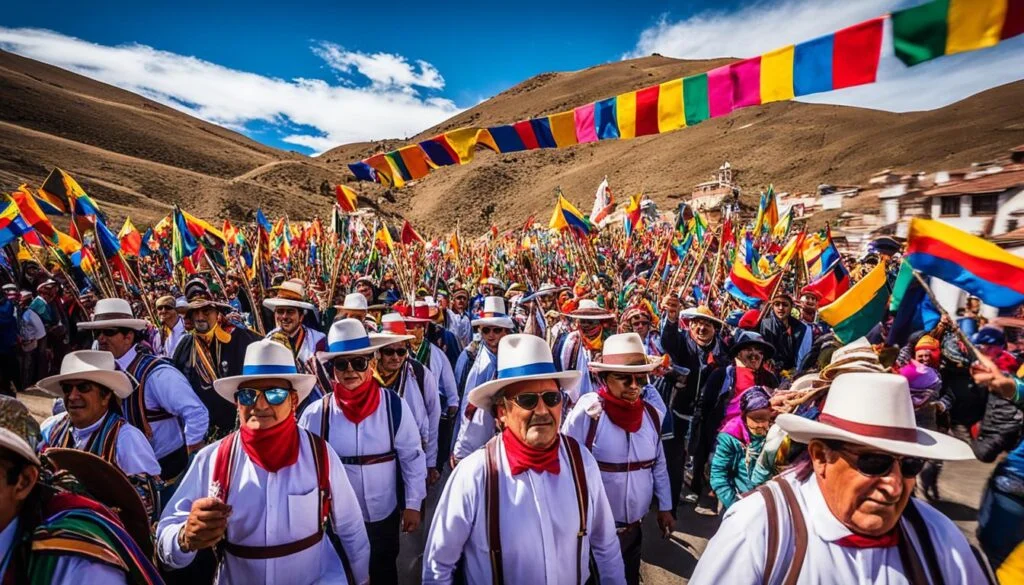
Religion plays a significant role in Bolivian culture, with over 90% of the population identifying as Catholic. However, indigenous beliefs and practices are also intertwined with Catholicism, resulting in a unique blend of spirituality.
The influence of Catholicism can be seen in the country’s architecture and customs, while indigenous traditions continue to be practiced by a minority of the population. The syncretism between Catholicism and indigenous beliefs reflects the cultural resilience and adaptability of the Bolivian people.
“The Bolivian people have found a way to reconcile their indigenous past with the dominant Catholic faith, creating a spiritual tapestry unlike any other.”
This syncretism is visible in Bolivian religious festivals and rituals, where elements of Catholicism and indigenous practices intertwine seamlessly. One example is the “El Señor del Gran Poder” festival, celebrated in La Paz, which combines Catholic traditions with Andean customs and dances.
While Catholicism holds sway over the majority of the population, indigenous beliefs and practices are deeply rooted in Bolivian culture, and they continue to be respected and celebrated by many. The spiritual connection to nature, ancestral reverence, and rituals honoring Pachamama (Mother Earth) are integral aspects of indigenous belief systems.
Together, Catholicism and indigenous beliefs shape the religious landscape of Bolivia, representing the cultural diversity and spiritual heritage of its people.
| Religion | Percentage of Population |
|---|---|
| Catholicism | 90% |
| Indigenous Beliefs | 10% |
Festivals Celebrating Bolivian Culture
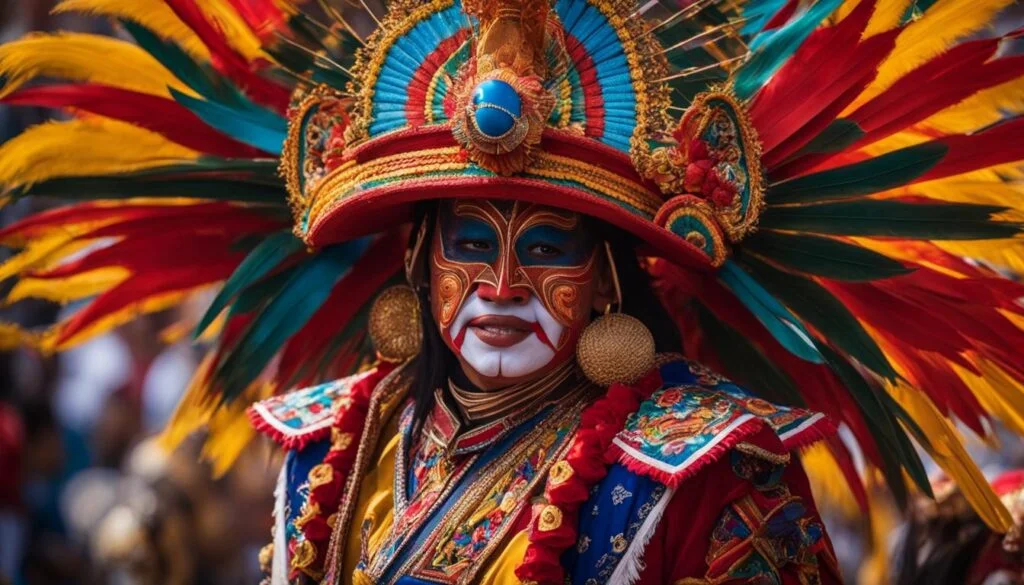
Bolivian culture truly comes alive in its vibrant festivals, offering a captivating blend of indigenous celebrations and cultural traditions. One of the most famous and cherished festivals in Bolivia is the Carnaval de Oruro. This grand event, held in February each year, brings together hundreds of thousands of participants from all over the country and beyond.
The Carnaval de Oruro is a spectacle that showcases the art, religion, and tradition of the Uru people. It is a harmonious fusion of indigenous rituals and Catholic traditions, reflecting the rich cultural heritage of Bolivia. The festival features ornate costumes, elaborate dances, and vibrant music, creating a mesmerizing experience for all who attend.
“The Carnaval de Oruro is a celebration that connects us to our indigenous roots and allows us to express our cultural pride,” says Julia Gomez, a Bolivian native and festival enthusiast.
In addition to the Carnaval de Oruro, other significant festivals in Bolivia offer a glimpse into the country’s cultural tapestry. The Great Power festival in La Paz is another prominent event that celebrates indigenous traditions through dance, music, and religious processions.
Furthermore, the celebration of the Virgin of Urkupiña in Cochabamba is another enchanting festival that draws both locals and tourists. It is a beautiful display of faith and devotion, as pilgrims embark on a journey to honor the Virgin Mary through colorful ceremonies and traditional dances.
These festivals provide a unique opportunity to immerse oneself in Bolivian culture, witnessing firsthand the passion, artistry, and reverence that define the country’s vibrant traditions.
| Festival | Location | Date |
|---|---|---|
| Carnaval de Oruro | Oruro | February |
| Great Power festival | La Paz | August |
| Celebration of the Virgin of Urkupiña | Cochabamba | August |
Attending these festivals is a unique cultural experience that allows visitors to appreciate the rich traditions, history, and diversity of Bolivian culture. It is an opportunity to witness the harmonious blend of indigenous celebrations and Catholic influences that shape the country’s cultural identity.
Language and Cultural Diversity in Bolivia
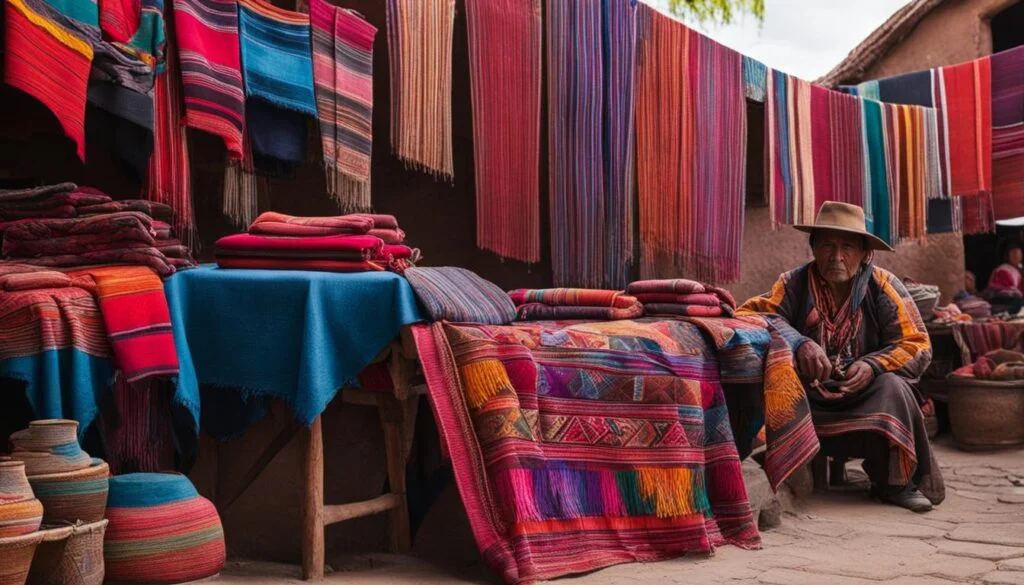
One of the fascinating aspects of Bolivian culture is its linguistic diversity, which reflects the country’s rich cultural heritage. While Spanish is the official language of Bolivia, indigenous languages like Quechua and Aymara are still widely spoken, particularly in rural areas and during market exchanges. This linguistic diversity is a testament to the country’s commitment to preserving and celebrating its indigenous heritage.
Indigenous languages hold significant importance in Bolivian society, as they form the basis of communication for many communities. They are passed down through generations, encapsulating the traditions, customs, and wisdom of the indigenous peoples. In recent years, efforts have been made to promote and protect these languages, recognizing their role in maintaining Bolivia’s cultural diversity.
Furthermore, English has become increasingly prevalent in Bolivia, especially in tourism-related industries. As the country attracts a growing number of international visitors, proficiency in English has become a valuable skill. This language shift is a result of Bolivia’s efforts to engage with the global community, foster economic development, and enhance communication with tourists.
The linguistic landscape of Bolivia offers a unique insight into the country’s cultural tapestry. The coexistence of Spanish, indigenous languages, and even English reflects the diversity and resilience of Bolivian culture.
To illustrate the linguistic diversity in Bolivia, here is a table showcasing some of the most widely spoken indigenous languages:
| Language | Number of Speakers | Region(s) |
|---|---|---|
| Quechua | Approximately 2.5 million | Andean regions, including La Paz and Potosí |
| Aymara | Approximately 2 million | Western highlands, including La Paz and Oruro |
| Guaraní | Approximately 56,000 | Eastern lowlands, including Santa Cruz and Tarija |
| Mojeño-Trinitario | Approximately 17,000 | Beni Department |
Bolivians take pride in their cultural and linguistic diversity, with each language playing a vital role in community identity and social interactions. The preservation and promotion of indigenous languages contribute to a deeper understanding and appreciation of Bolivian culture as a whole.
Traditional Clothing and Fashion in Bolivian Culture
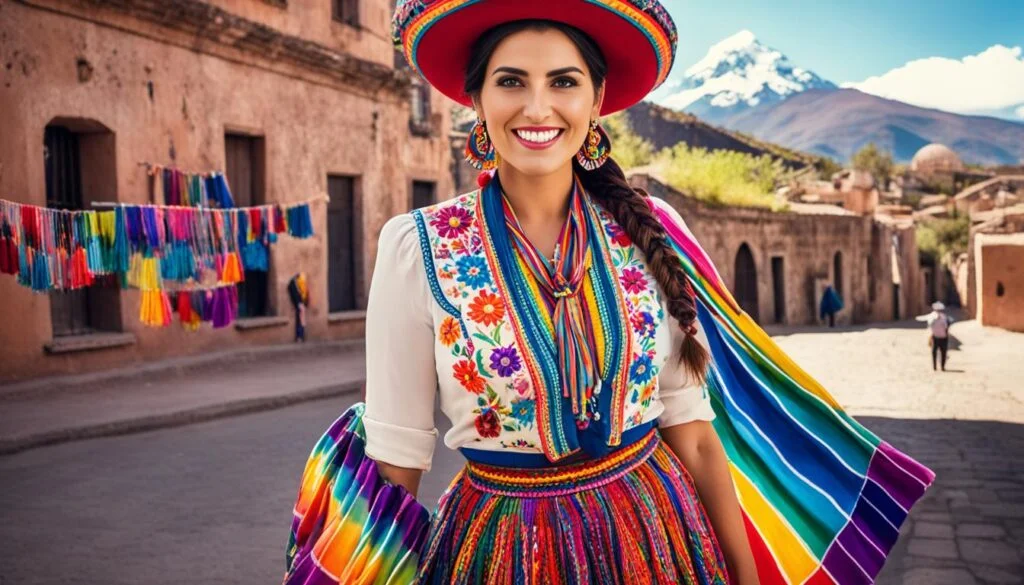
Traditional clothing in Bolivia is an integral part of the country’s cultural identity. The diverse regions and occasions give rise to a variety of traditional garments that showcase the unique heritage and pride of the Bolivian people.
In urban areas, Western-style clothing has become more prevalent, reflecting modern influences. However, rural communities continue to maintain their rich tradition of wearing traditional clothing, preserving the unique cultural expressions of their ancestors.
One of the most iconic pieces of traditional clothing worn by Bolivian women is the pollera, a vibrant and pleated skirt. The pollera is often worn with layers of clothing, including sweaters, shawls, and hats, adding to the intricacy and beauty of the ensemble. This traditional attire showcases the indigenous influences and craftsmanship that have been passed down through generations.
On the other hand, men’s traditional clothing typically includes ponchos and vests, which are often adorned with intricate patterns and designs. These garments not only reflect the cultural heritage but also represent the practical needs of the local climate, providing warmth and protection.
The preservation of traditional attire in Bolivia is seen as an important form of cultural pride and identity. By embracing and wearing these garments, Bolivians honor their ancestors and contribute to the vibrant tapestry of Bolivian culture.
The Arts and Cultural Expressions in Bolivia
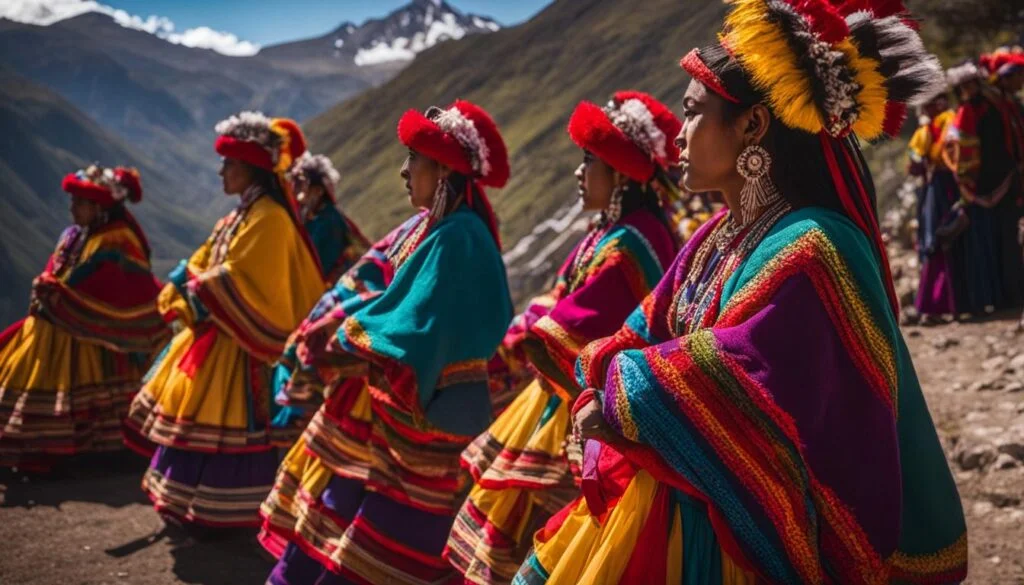
Bolivia has a thriving artistic community, with painters, sculptors, musicians, and dancers gaining recognition both nationally and internationally. The country boasts numerous theaters, art galleries, and museums, showcasing traditional Bolivian music, art, and archaeological treasures. From the National Museum of Art and the National Museum of Archaeology in La Paz to the Casa de Moneda National Museum in Potosí, visitors can delve into the rich cultural expressions and artistic heritage of Bolivia.
One of the most notable forms of expression in Bolivian culture is music. From the haunting sounds of panpipes and charangos to the rhythmic beats of drums and tambourines, music is deeply ingrained in the traditions and celebrations of the country. Traditional dances, accompanied by live music, are a vibrant representation of Bolivian culture, with each region showcasing its unique style and movements.
Bolivia’s traditional dances are an integral part of cultural festivities and rituals, preserving centuries-old traditions and reflecting the country’s diverse indigenous heritage. The Diablada dance, celebrated during the Carnaval de Oruro, is a mesmerizing spectacle that combines elements of Catholicism with indigenous folklore. The Tinku dance, originating from the Andean region, is a powerful display of martial arts-like movements, representing the struggles and resilience of indigenous communities.
Bolivia’s cultural heritage and artistic expressions are also evident in the visual arts. Artists from Bolivia create remarkable paintings, sculptures, and textiles that capture the beauty and essence of the country’s landscapes, people, and cultural traditions. These works of art can be found in galleries and exhibitions throughout the country, showcasing the immense talent and creativity of Bolivian artists.
To fully appreciate the arts and cultural expressions in Bolivia, a visit to the country’s museums is a must. The National Museum of Art in La Paz houses an extensive collection of contemporary and traditional Bolivian art, providing insight into the country’s artistic evolution. The National Museum of Archaeology in La Paz offers visitors the opportunity to explore Bolivia’s pre-Columbian past through a wide range of artifacts and archaeological discoveries.
Bolivia’s Casa de Moneda National Museum in Potosí is a fascinating testament to the country’s colonial history and the importance of silver mining in shaping its economy. The museum displays coins, machinery, and documents, shedding light on the intricacies of the colonial minting process and its impact on Bolivia’s cultural and economic development.
Famous Bolivian Artists
| Artist | Art Form | Notable Works |
|---|---|---|
| Roberto Mamani Mamani | Painting | “Mujer Luna” series |
| Marina Núñez del Prado | Sculpture | “Mama Juana” series |
| Eduardo “Sacha” Barrio | Music | “Kjarkas” band |
| María Esther Ballivián Siles | Textile Art | Handwoven tapestries |
The arts and cultural expressions in Bolivia serve as a means of preserving and celebrating the country’s diverse heritage. They provide an insight into the customs, traditions, and beliefs of the Bolivian people, allowing visitors to connect with the rich tapestry of Bolivian culture.
Conclusion
Bolivia’s culture is a fascinating tapestry of diverse traditions and expressions, rooted in its rich history and influenced by indigenous heritage and Spanish influences. From its unique cuisine to vibrant festivals, traditional clothing, and thriving arts scene, Bolivian culture is a celebration of the country’s cultural heritage.
Exploring Bolivian culture allows visitors to immerse themselves in the vibrant colors, flavors, and rhythms that make this country truly unique. The fusion of indigenous traditions and colonial influences creates a fascinating blend of customs and practices that continue to shape the way of life in Bolivia.
By embracing Bolivian culture, visitors can gain a deeper understanding and appreciation for the country’s cultural heritage. Whether it’s indulging in traditional Bolivian cuisine, witnessing the spectacle of the Carnaval de Oruro, or admiring the intricate craftsmanship of indigenous textiles, every aspect of Bolivian culture offers a window into the rich tapestry of traditions that define this diverse nation.

